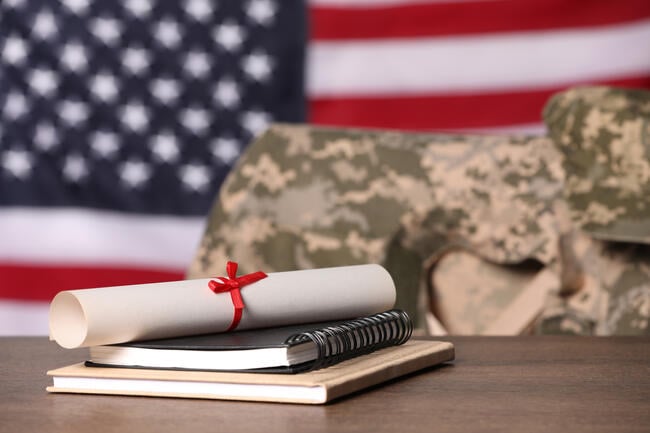You have /5 articles left.
Sign up for a free account or log in.

Liudmila Chernetska/iStock/Getty Images Plus
For generations, America’s investment in its veterans has been unwavering and bipartisan. It has also produced spectacular results. Consider the first GI Bill, signed into law by President Franklin D. Roosevelt on June 22, 1944. By 1947, just three years after the bill was adopted, about half of America’s college students were veterans. When the legislation expired in 1956, 7.8 million veterans had used its education benefits, 2.2 million of them to attend college or university.
Today, that bipartisan commitment to veterans is under threat. Recent cost-cutting proposals from the Trump administration risk jeopardizing veterans’ benefits and the essential services veterans rely on, as well as veterans’ employment in the public sector. In light of these cuts, it’s more important than ever that veterans take full advantage of the transformational postsecondary educational benefits that the government is continuing to support.
Successor GI Bills, administered by the Department of Veterans Affairs, have proven to be crucial engines of upward mobility. And yet too few veterans are taking full advantage of what the GI Bill offers. Indeed, veterans remain significantly underrepresented across higher education. According to recent data, only about one in three veterans (31 percent) hold at least a bachelor’s degree—which is below the national average (35 percent) for those 25 and older. Yet more than half (53 percent) of veterans and service members surveyed by Syracuse University’s Institute for Veterans and Military Families cited educational benefits as a key reason for joining the military. Were the bachelor’s attainment rate among veterans to reach 53 percent, that would mean about four million more veterans with college degrees.
If we want to come anywhere close to realizing this kind of increase (and, therefore, realizing a return on our country’s critical investment in veterans’ educational benefits), it will be crucial to ensure that vets attend institutions where they are both more likely to graduate and more likely to receive the kind of noncurricular support that can help them navigate the return to school.
Instead, veterans have, over the last several decades, disproportionately enrolled in for-profit institutions, which often fail to deliver the same career outcomes as our nation’s public and private nonprofit colleges. In 2015–16, veterans made up 13 percent of students at two- and four-year for-profit institutions, despite accounting for just 5 percent of all enrolled students nationally. Encouragingly, Post-9/11 GI Bill beneficiaries have been shifting away from for-profit institutions. And federal legislative action closed a loophole that had allowed for-profit colleges to count veterans’ educational benefits as nonfederal funds.
To build on this trend, we should be expanding high-quality postsecondary opportunities for veterans. Data continues to show a rise in wage premiums and career satisfaction associated with four-year degrees. But the GI Bill doesn’t just benefit the students who take advantage of it—colleges where veterans enroll and society at large benefit, too. Not only do these students bring distinctive experiences and perspectives to classrooms and campuses, but institutions that open their doors to veterans are also likely to earn public appreciation across the political spectrum for providing opportunity to those who have given years of service to the nation.
Indeed, our most selective and highly endowed institutions, many of which have come under fire of late for their failure to serve the public good, might regain some of that trust by embarking on a push to enroll significant numbers of veterans. As institutions work to ensure a diversity of opinions on campus, recruiting more veterans can help, as they have different life experiences and are often first-generation students.
Educational benefits are only the start. We also need to create pathways and support structures to help veterans get to and succeed in higher education and beyond. Philanthropy has a role here. Foundations, nonprofits and private donors can step in to provide scholarships, mentorship programs and emergency financial aid to ensure veterans have the resources and support they need to go back to college and succeed once they get there.
This is all the more important as institutions are facing a need to reduce support services due to federal pressure. Organizations like Service to School and the Warrior-Scholar Project have prepared and connected thousands of veterans to high-quality educational opportunities. A more robust ecosystem of partnerships between colleges, universities and nonprofit providers is needed to bridge the gaps likely to be left by diminishing government support.
Since World War II, America has repeatedly promised to take care of its veterans, but promises alone are not enough. We must financially prioritize strengthening the VA, including by shoring up GI Bill benefits and investing in proven programming and pathways to higher education to ensure veterans are given the tools they need to thrive. If we fail them now, we fail the very people who fought for us. It’s time to do better.




